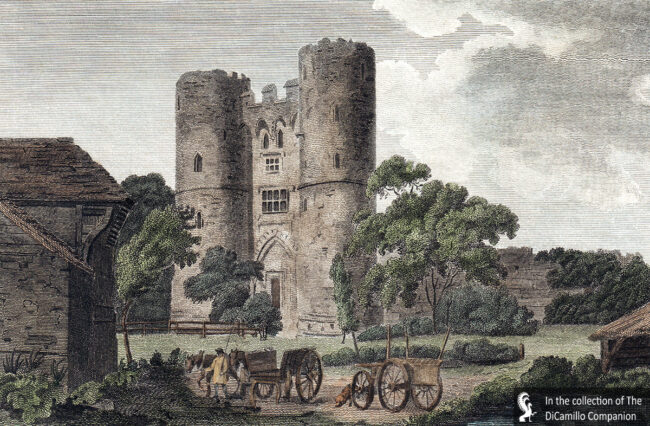
The castle from a circa 1800 hand-colored engraving
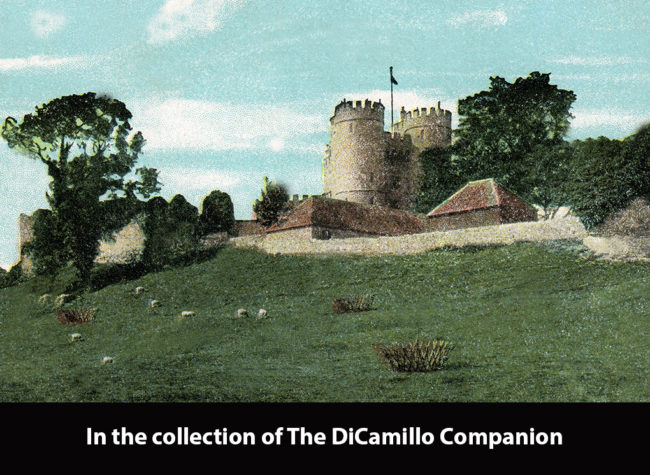
The castle from a circa 1910 postcard
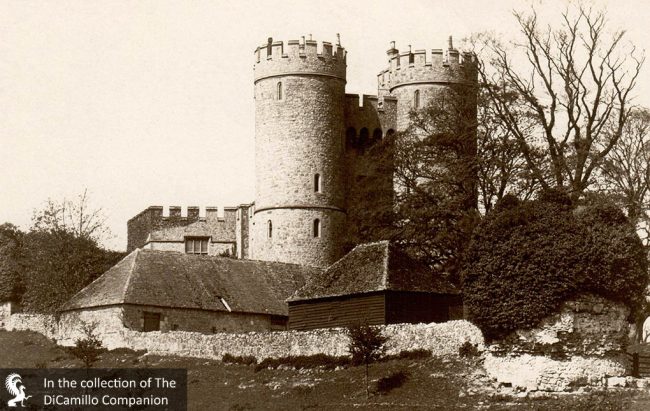
The castle from a circa 1906 postcard
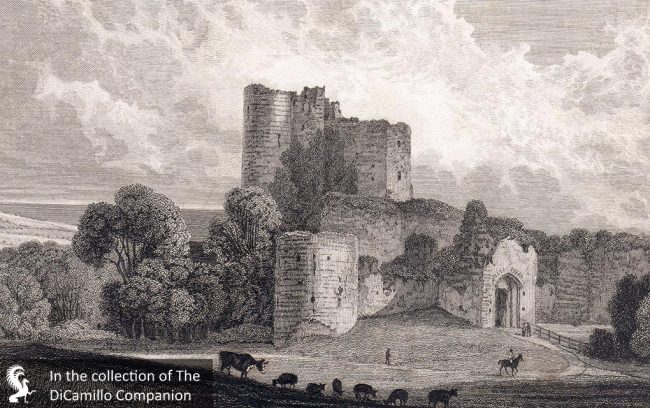
An 1829 engraving of the castle from "Virtue's Picturesque Beauties of Great Britain"
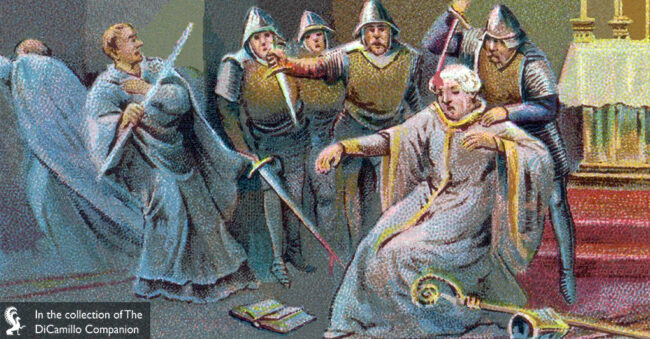
Illustration of the murder of Becket from a 1913 British cigarette card
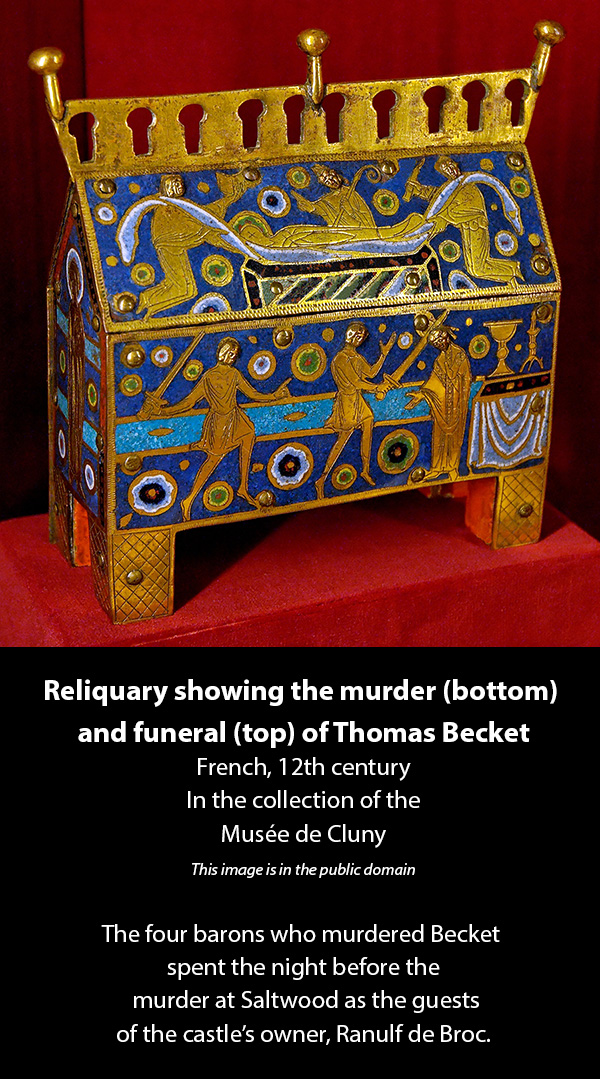
Earlier Houses: There were earlier buildings on the site of the current castle.
House & Family History: Saltwood Castle was very likely built on the site of a Roman settlement and there is much evidence of Bronze Age activities in the area. During the reign of King Cnut (Canute), 1016-35, Saltwood was given to the Priory of Christ Church, Canterbury. During the 12th century the castle became a private home as the seat of Henry d'Essex, constable of England. In the mid-12th century, the Archbishop of Canterbury, Thomas Becket, petitioned King Henry II to return Saltwood to the church for use as an ecclesiastical palace; the king instead conveyed the house to Ranulf de Broc, one of his loyal barons. Henry II's transfer of Saltwood to de Broc led to speculation that de Broc was complicit in the plot to murder Thomas Becket. Certainly the four barons who murdered Becket (Reginald FitzUrse, William de Tracy, Hugh de Morville, and Richard Brito) spent the night before archbishop's murder at the castle as the guests of de Broc. And, of course, it's conceivable that the barons could have planned Becket's murder while staying at Saltwood (they left the next morning and murdered Becket in Canterbury Cathedral on December 29, 1170). Though it seems clear today that the king did not specifically authorize Becket's killing, he did create a charged atmosphere, calling Becket a traitor and ordering his arrest. The traditional phrase attributed to Henry about Becket, "Will no one rid me of this turbulent priest?," is now believed to be a later creation with little basis in fact. It's much more likely (according to Anne Duggan, writing in "BBC History," Vol. 13, No. 12) that the king said "What useless drones and traitors have I nourished in my court – who let their lord be treated with such contempt by a low-born clerk." As part of Henry II's penance for his perceived involvement in the murder of Becket, Saltwood Castle was returned to the archbishops of Canterbury; it remained in church hands until the reign of Henry VIII, when, during the Dissolution of the Monasteries, the crown seized the castle. The earthquake of April 6, 1580 left Saltwood uninhabitable; it remained so until it was restored as a residence of the archbishop of Canterbury in the 19th century. In 1919 the castle was inherited by the father of Lord William Deedes, but sold in 1929 after the family experienced financial difficulties as a result of the 1929 stock market crash. Bill Deedes, as he preferred to be known, spent a significant part of his childhood at Saltwood. He later became a noted journalist and politician and was the only person in Britain to have been both a member of the British cabinet and the editor of a major daily newspaper. Saltwood is most famous today as the home of the art historian Sir Kenneth Clark (created a life peer as Lord Clark of Saltwood in 1969), who purchased the castle in 1955. Lord Clark is best remembered for his ground-breaking 1969 BBC television mini series, "Civilisation: A Personal View" (such was his fame from this TV series that the British satirical magazine "Private Eye" dubbed him Lord Clark of Civilisation). After Lord Clark's death in 1983, his son, Alan Clark, a Conservative politician and minister in Margaret Thatcher's government, inherited Saltwood and made the castle his seat. Alan Clark was also a noted political diarist (he published his diaries in 1993, which became a TV series in 2004).
Garden & Outbuildings: The gatehouse has been used as a residence since the 19th century.
Country Life: XCII, 986, 1034, 1082, 1942.
Title: BBC History (magazine)
Author: NA
Year Published: NA
Reference: Vol. 13, No. 12, "The Cult of Thomas Becket" by Anne Duggan, pgs. 76-77.
Publisher: Bristol: Immediate Media Company Bristol
ISBN: NA
Book Type: Magazine
Title: In Celebration: The Art of the Country House
Author: Hearn, Karen; Upstone, Robert; Waterfield, Giles
Year Published: 1998
Publisher: London: Tate Gallery Publishing
ISBN: 1854372777
Book Type: Softback
House Listed: Grade I
Park Listed: Not Listed
Current Seat / Home of: Jane Clark
Past Seat / Home of: Birdnax family, 11th century. Henry d'Essex, 12th century. Ranulf de Broc, 12th century. Gilbert de Southworth, 14th century. Alice D'Ewyas, 14th century. Thomas Braddyll, from 1678. John Cooper, 1850-62. Joseph Harrison, 1862-78. Archbishop of Canterbury, 19th century. Deedes family, 1919-29. Sir Kenneth Mackenzie Clark, Baron Clark of Saltwood, 1955-83; Alan Kenneth Mackenzie Clark, 1983-99.
Current Ownership Type: Individual / Family Trust
Primary Current Ownership Use: Private Home
Ownership Details: Owned by Saltwood Heritage Foundation